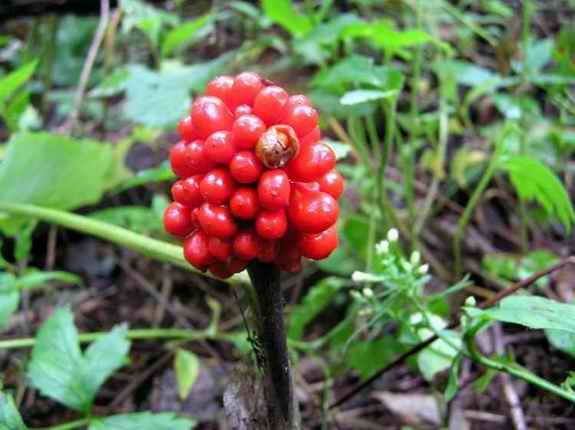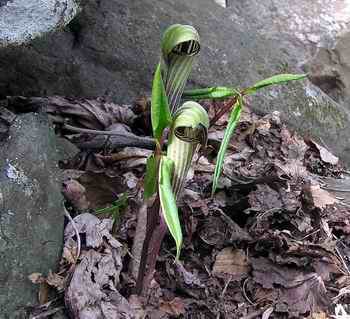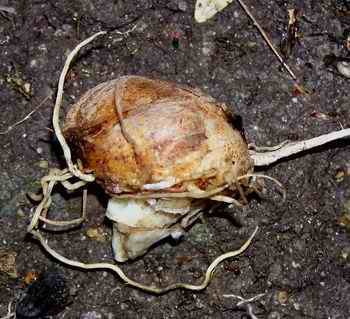|
Return to Hiker's Notebook Home Page Common Name: Jack-in-the-Pulpit, Parson-in-the-Pulpit, Lord-and-Lady, Cuckoopint, Aronskelk , Indian Turnip, Iroquois breadroot, Starchwort, Memory root, Bog onion, American arum, Devil's ear, Pepper turnip, Dragonroot, Wake robin, Cooter-Wampee, Plant-of-Peace, Cobra lily, Petit precheur (Quebec). Scientific Name: Arisaema triphyllum (The generic name is a combination of the Greek word aris which is the name of another member of the Arum family [Araceae], and haema meaning blood referring to the red coloration of the berries; Triphyllum means three leaved and refers to the fact that there are three leaves that extend from the stem).
The singular appearance of the Jack-in-the-Pulpit's mace-like cluster of red berries at the top of an otherwise bare stem has inspired a plethora of folk names, each with a parochial etymology. Many of the names were originally from various European species of the arum family with similar taxonomies that were later applied to the native A. triphyllum by early settlers. Arums are characterized by the flower-bearing spadix which is at the center of the plant surrounded by the leafy sheath-like spathe. The red berry cluster is the seed bearing remnant of the spadix after the spathe has fallen away.
Jack (or Parson) in the Pulpit alludes to the resemblance of the spadix (Jack) in the spathe (Pulpit) to a country parson perched on an elevated stand over his congregation. Lord and Lady refer to either the ostentatious costume of the spadix wrapped in the royal purple spathe or to the phallic appearance of the spadix in the vaginal spathe. Cuckoopint is a contraction of Cuckoo pintle, which is a bolt or pin, or, in the vernacular, a penis. More scatological vernacular names include Dog's dilly and Priest's pintle. A religious variant proffers "Our Lady and Our Lord," the spathe symbolizing the Virgin Mary's cloak as she protects the infant spadix. Aronskelk is a calque of the Dutch Aaron's chalice, referring to Aaron who was offered a "kelk" of wine by an angel when his brother Moses was chosen to lead his people to freedom; the shape of the spathe resembling that of a drinking vessel. The taxonomy of members of the arum family (skunk cabbage is another) in general and of A. triphyllum in particular is an interesting case of evolutionary adaptation. The spathe surrounds and protects the flower bearing spadix from predation while attracting and confining pollinating insects, particularly gnats. The plant emits a fungal smell that attracts the insects to the spathe, the enclosure keeping them confined to ensure that the flowers of the spadix are pollinated. The three leaves for which the species name triphyllum is applied extend from the top of a separate stalk.
A second anomalous adaptation of the Jack-in-the-Pulpit is that any plant can become a male or a female according to the environmental conditions sensed by the corm. A corm is a swollen section of the stem that is underground, functioning as a food reservoir. It is similar to a tuber except that the tuber is an enlarged section of an underground branch of the stem called a stolon that extends horizontally; the corm is on the stem and is vertical. A potato is a tuber and a taro (a popular tropical food source from which Hawaiian poi is made) is a corm. If conditions are favorable, the corm produces the female plant with its characteristic red-berried spadix. Otherwise, it produces a single-leaf male plant, storing the extra energy for future generations.
A. triphyllum contains a high concentration of crystals of calcium oxalate which is a salt of oxalic acid (COOH), a weak acid that is an ingredient in some bleaches and anti-rust metal cleaners. The chemical permeates the plant, protecting it from ingestion by insects and animals, though it is especially concentrated in the corm. Ingestion of calcium oxalate results in a burning sensation that has been characterized as like needles being stuck into the tongue and throat, the crystals becoming embedded in the soft tissues of the mouth. Some species of arum have a high enough concentration of oxalic acid in the berries that children who have eaten them suffer severe convulsions and cramps which resulted in death when no medical attention was available.
The high potency of A. triphyllum gave rise to its widespread use by Native Americans. A number of Indian tribes, notably the Meskwaki and the Potawatomi, used the corm as a diagnostic tool for health assessment. A seed was placed in a cup or water and if it circulated clockwise four times before it sank, then the patient would get well; if not, he died. According to what may be an apocryphal legend, the Meskwaki ground up the corm and mixed it with meat which they left on the trails of their enemies, the Sioux. Ingestion resulted in an agonizing death in several hours. They called the plant the "tcika-tape" which literally translates as bad sick.
Knowledge of the qualities of A. triphyllum passed from the Native Americans to the early colonists. The corm was made into a poultice that was applied to external sores, to joints to reduce the painful inflammation of rheumatism and to reduce the swelling from snakebites. A tea made from powdered corm was used as an expectorant and purgative. A starch was made from the corms to stiffen clothes, though it was reportedly very harsh on the hands which became blistered and swollen. The name Starchwort was thus obtained. Country youth purportedly coaxed unsuspecting visitors to take a bite of the corm with predictable results. Fortunately, cold milk was found to alleviate the burning sensation and cramping. The name Memory root attests to this unforgettable experience.
As with many plants having unusual taxonomies, legend and lore extend to signify their notoriety. Jack-in-the-Pulpit thus grew at the base of the cross of Calvary, the striations of the petals due to the fallen blood. The soldiers of Caesar's army are said to have subsisted on the plant (called Chara) when they were encamped at Dyrrhachium. Aristotle is attributed with the notion that bears who had been in hibernation for forty days without any sustenance were completely restored when they ate it. The arum was afforded a mystical significance as "Janus's Plant" as it seemed to glow from within as an invitation to the gates of heaven; Janus was the Roman god of the beginning and the end from which the name of the month of January is derived. |


 It
is testimony to the adaptability of the Native Americans that the corm of the
Jack-in-the-Pulpit became a source of food and medicine. The names Indian
turnip and Iroquois breadroot refer to the discovery that the corm could be
either roasted or dried for six months to neutralize the harmful acidity.
After drying, the corm was peeled and ground into flour from which bread was
made. Medicinally, the aged corm was used as a treatment for colds and dry
coughs and as a general palliative for "building blood." Powdered corm
dissolved in water was used as a means of contraception, one dose to prevent
conception for one week and two doses to induce permanent sterility.
It
is testimony to the adaptability of the Native Americans that the corm of the
Jack-in-the-Pulpit became a source of food and medicine. The names Indian
turnip and Iroquois breadroot refer to the discovery that the corm could be
either roasted or dried for six months to neutralize the harmful acidity.
After drying, the corm was peeled and ground into flour from which bread was
made. Medicinally, the aged corm was used as a treatment for colds and dry
coughs and as a general palliative for "building blood." Powdered corm
dissolved in water was used as a means of contraception, one dose to prevent
conception for one week and two doses to induce permanent sterility.